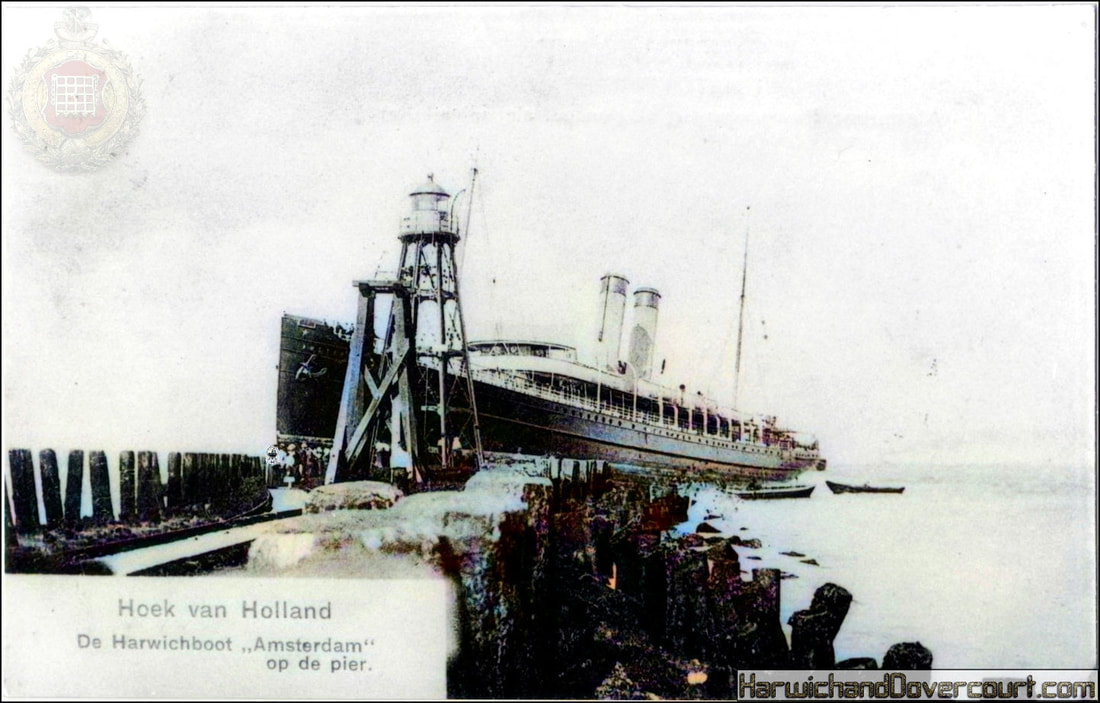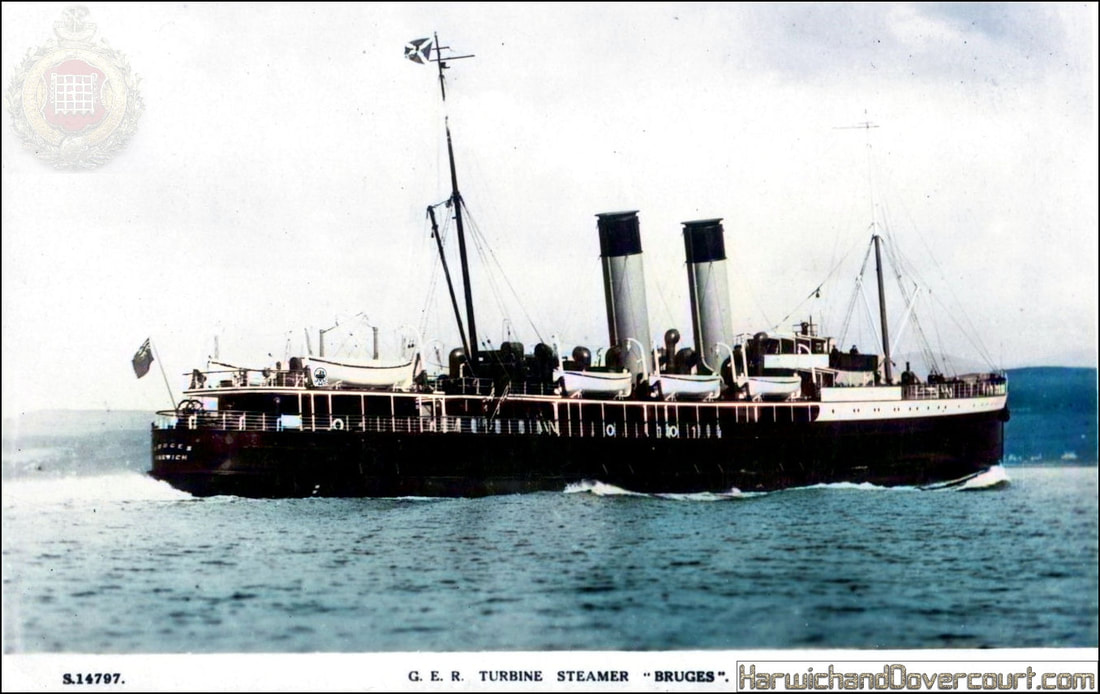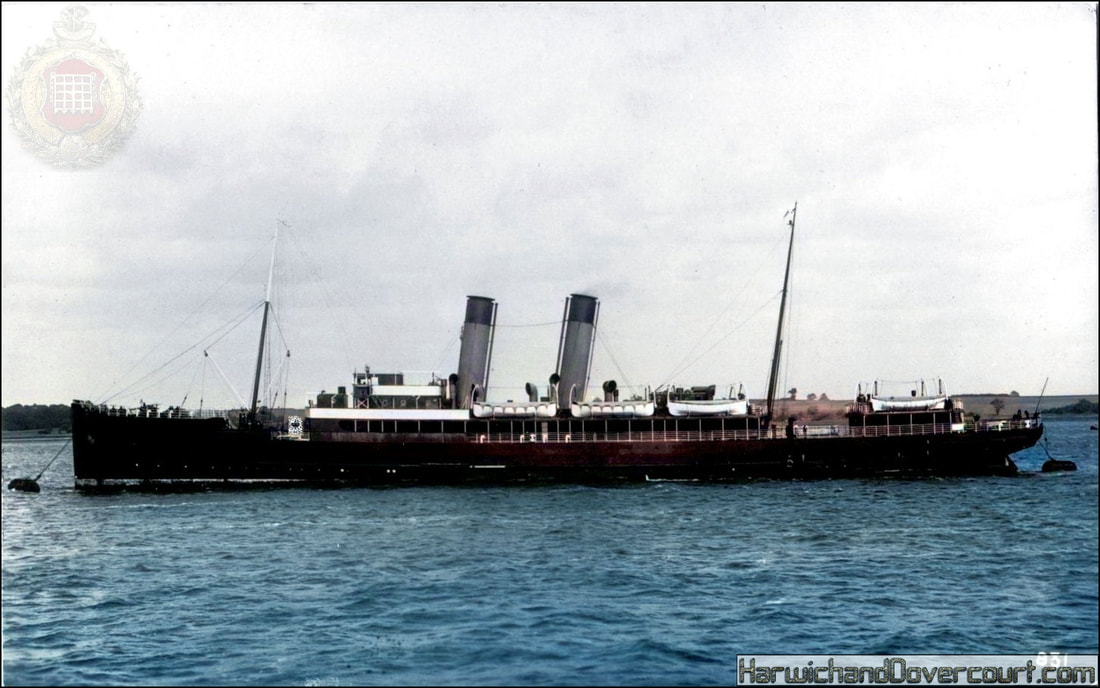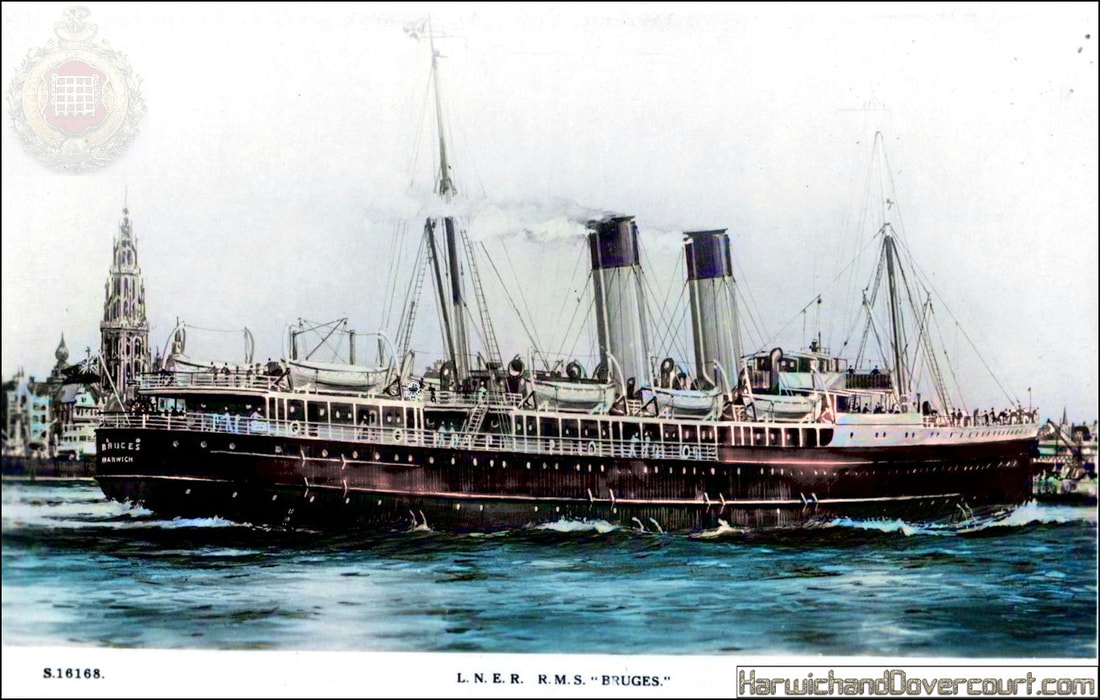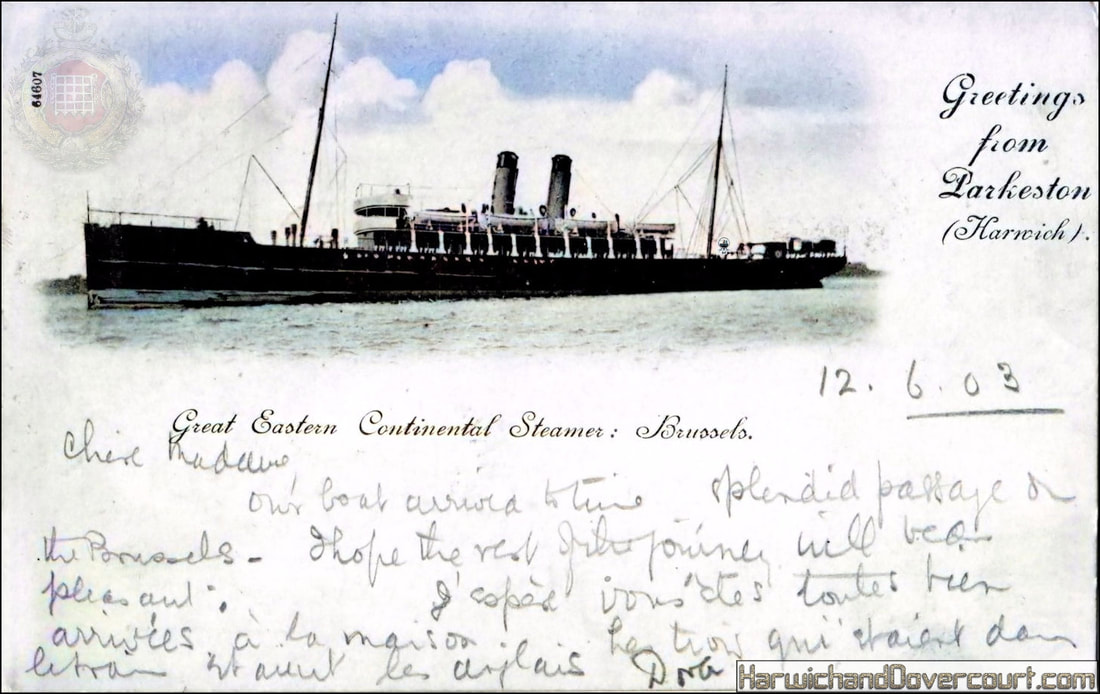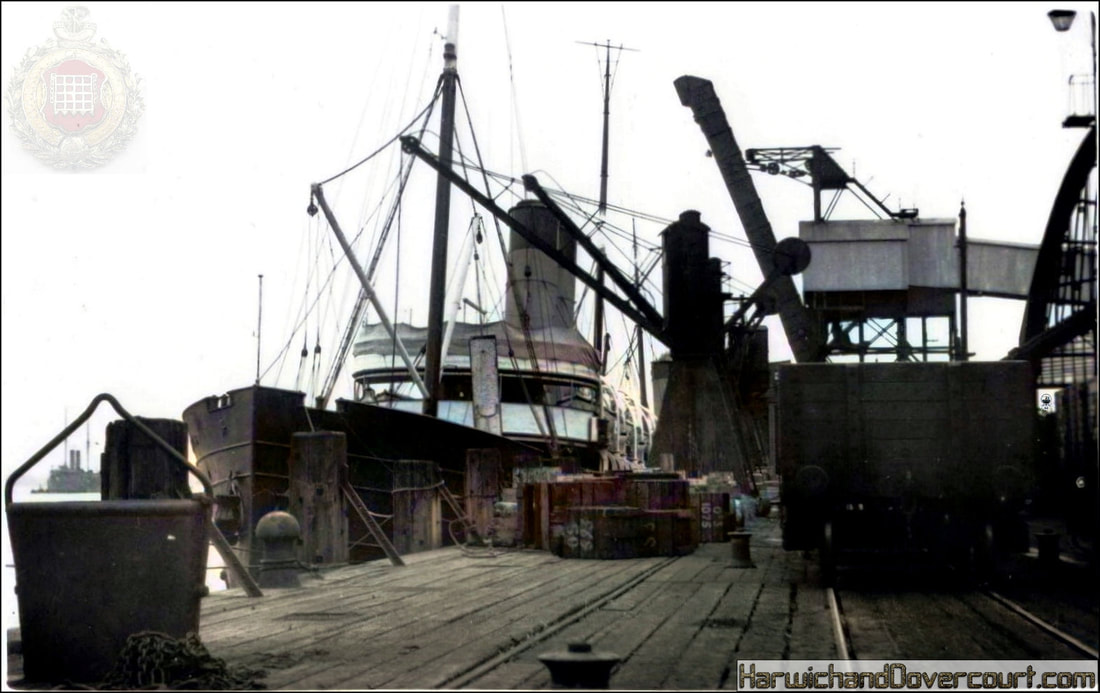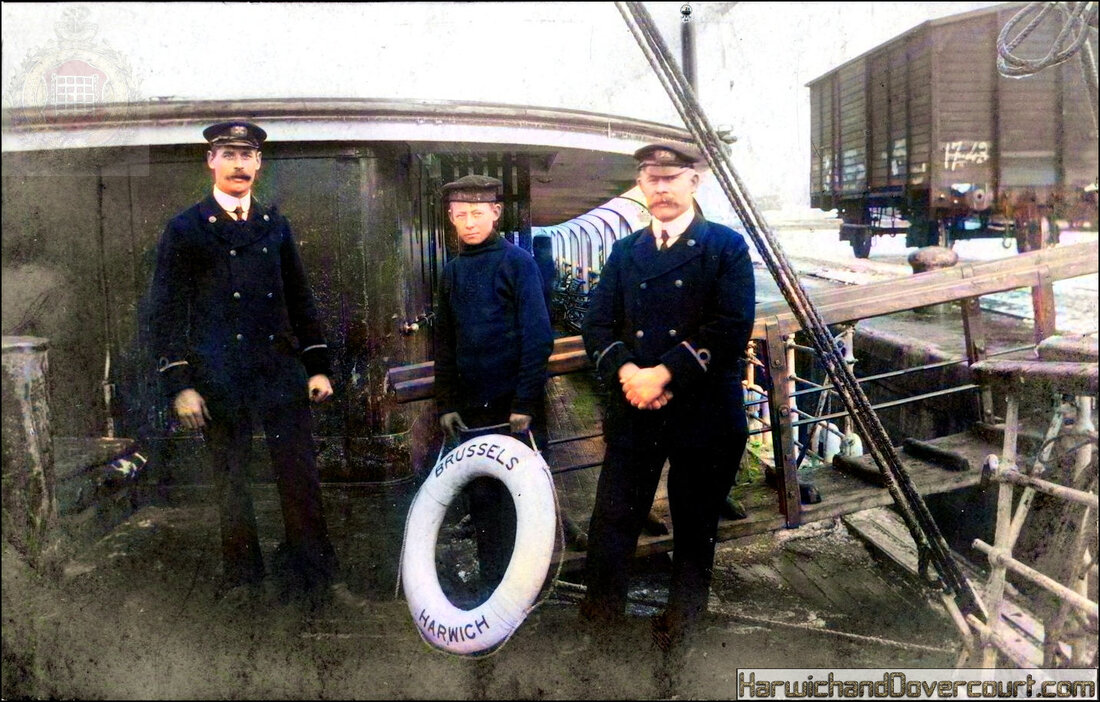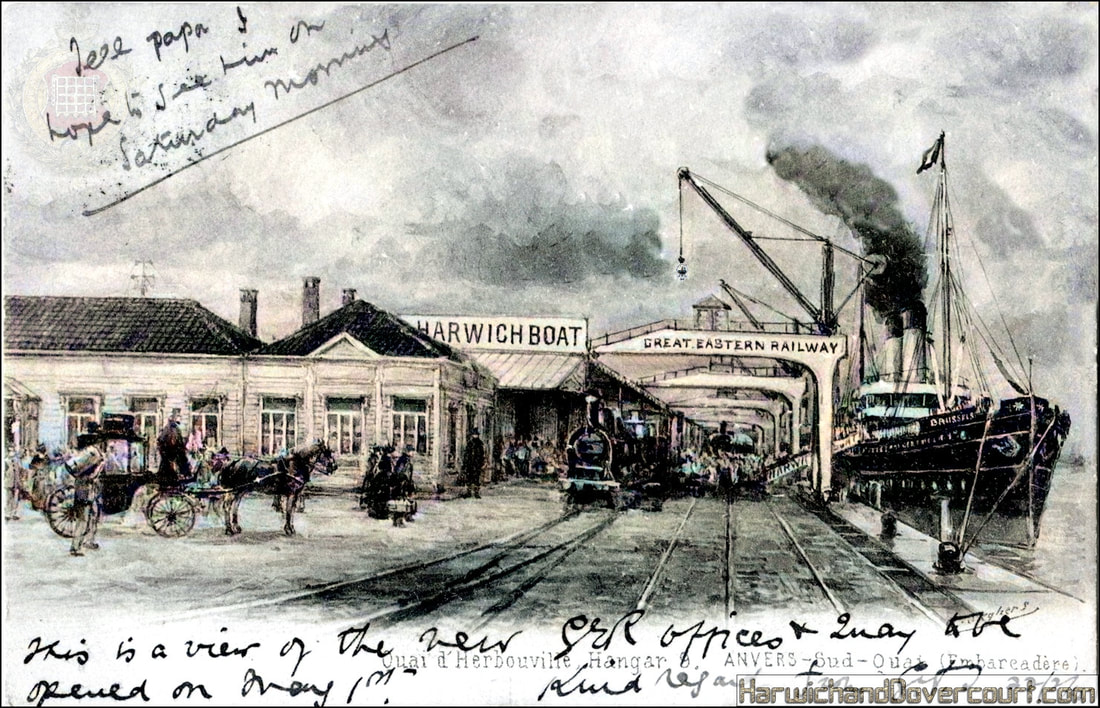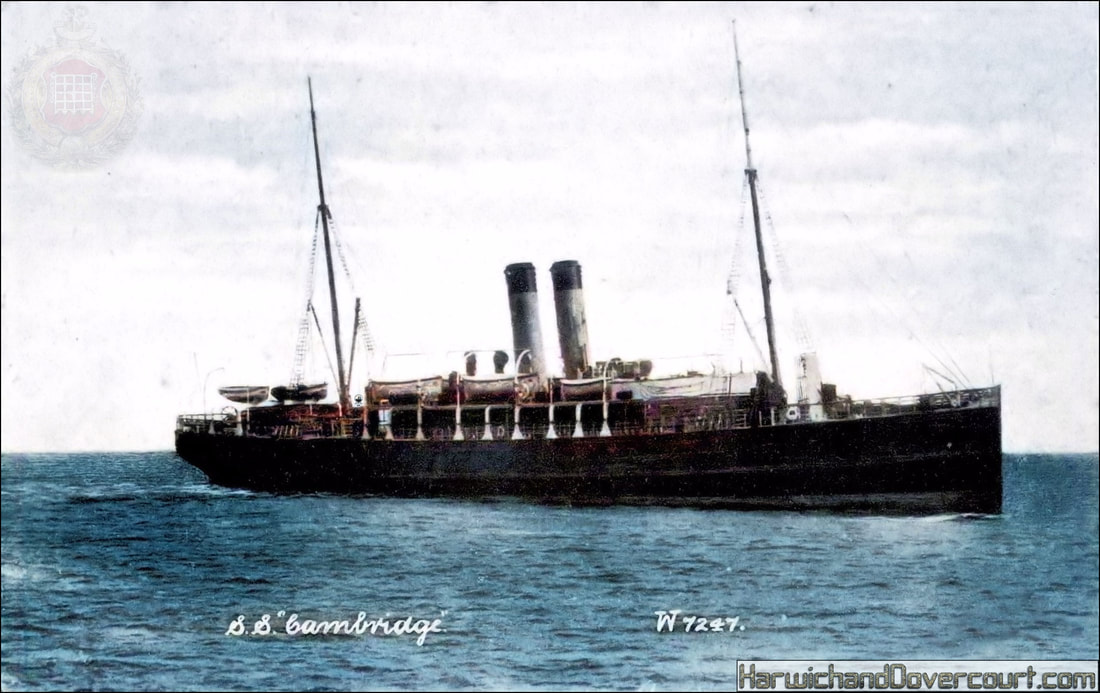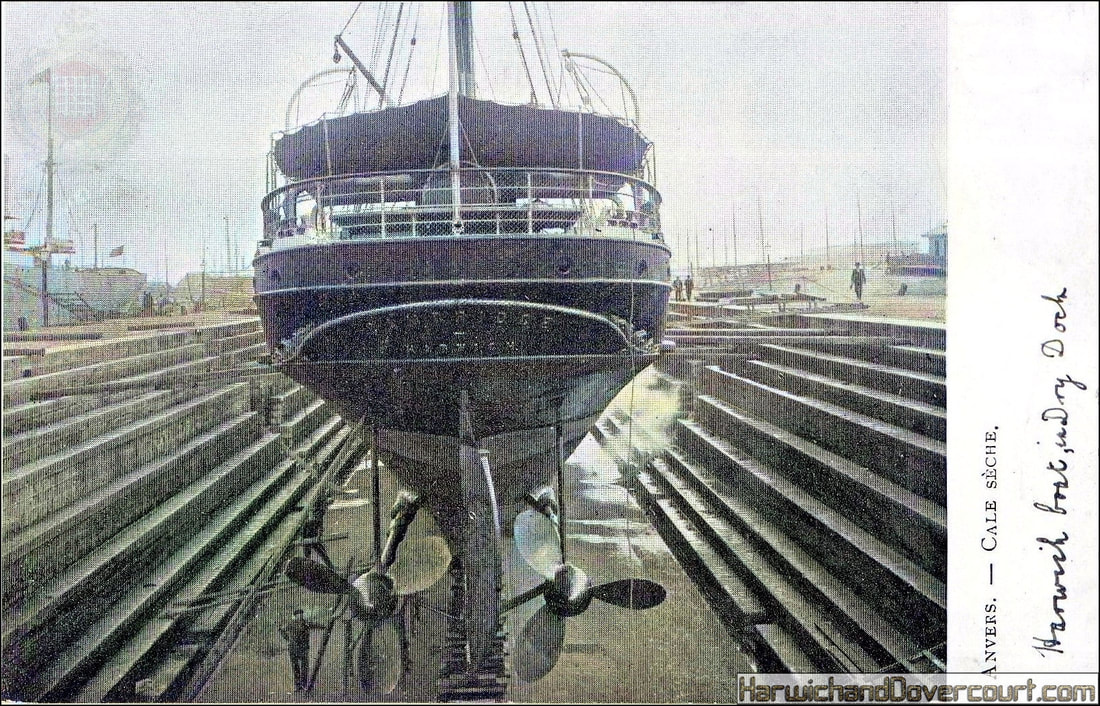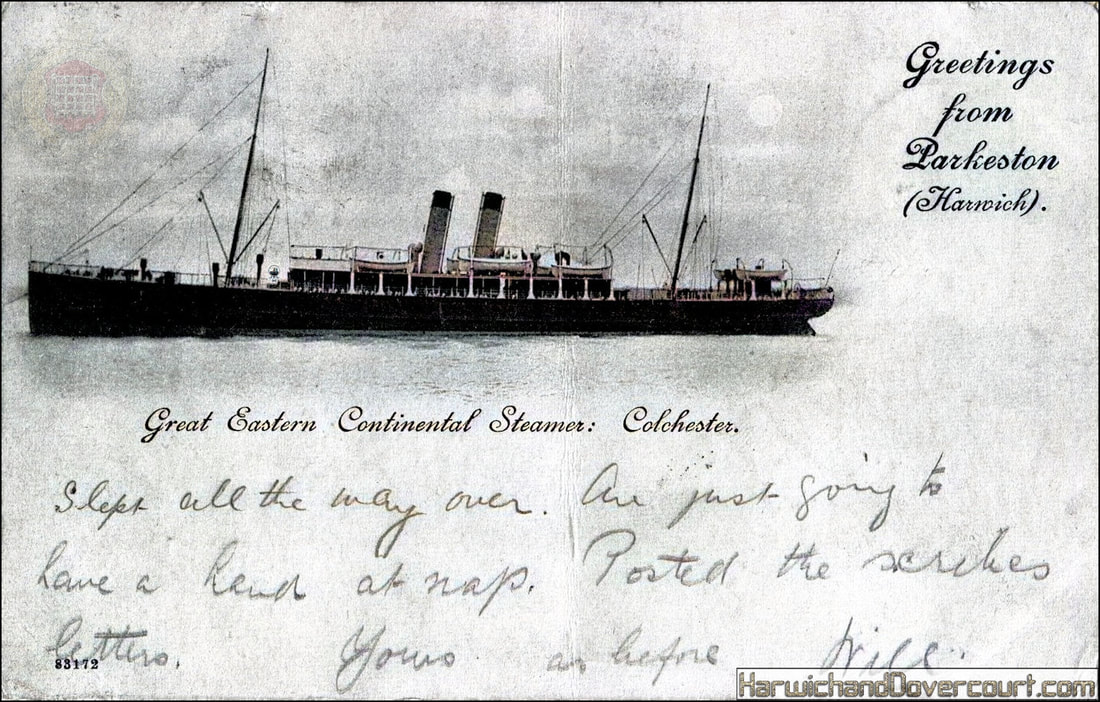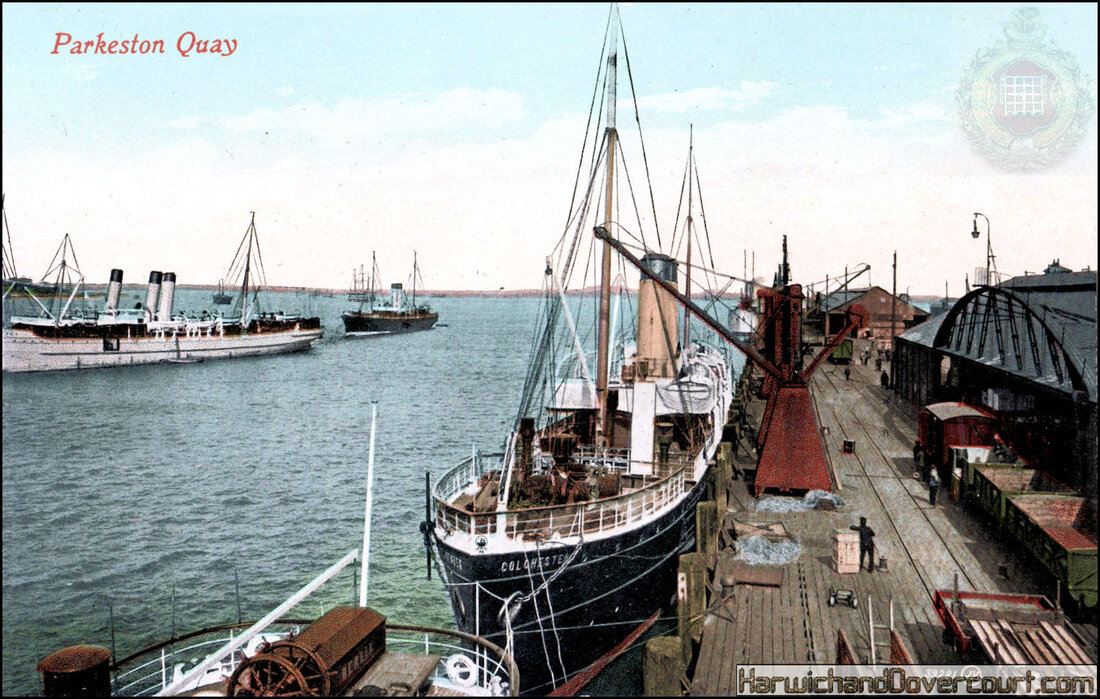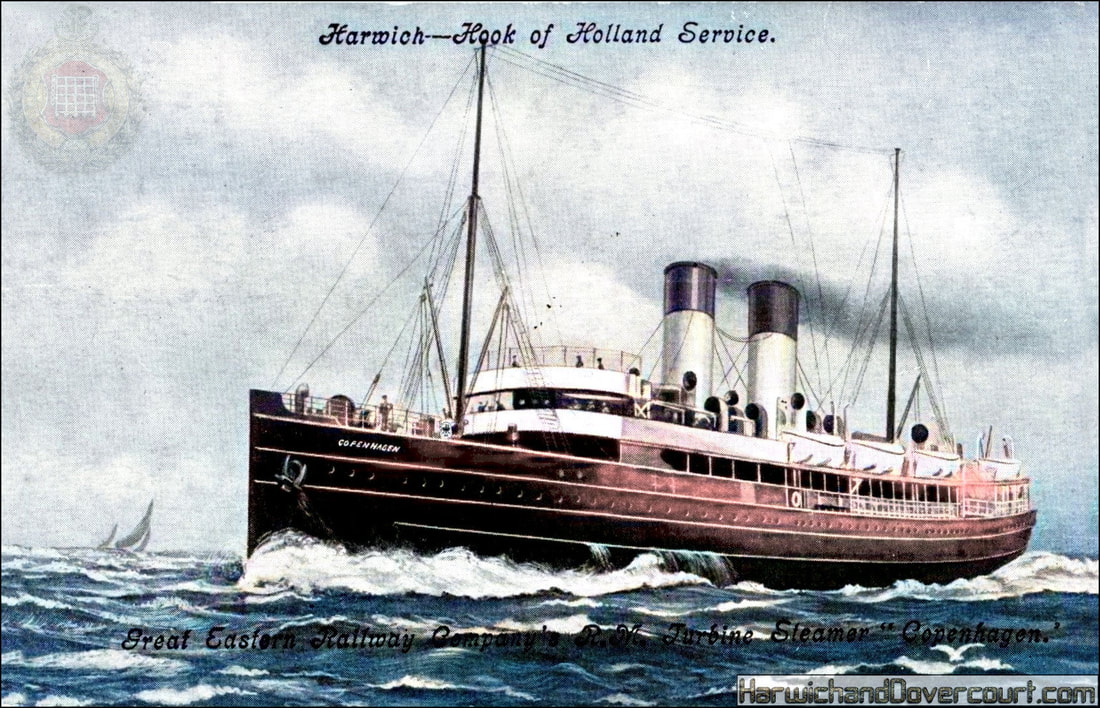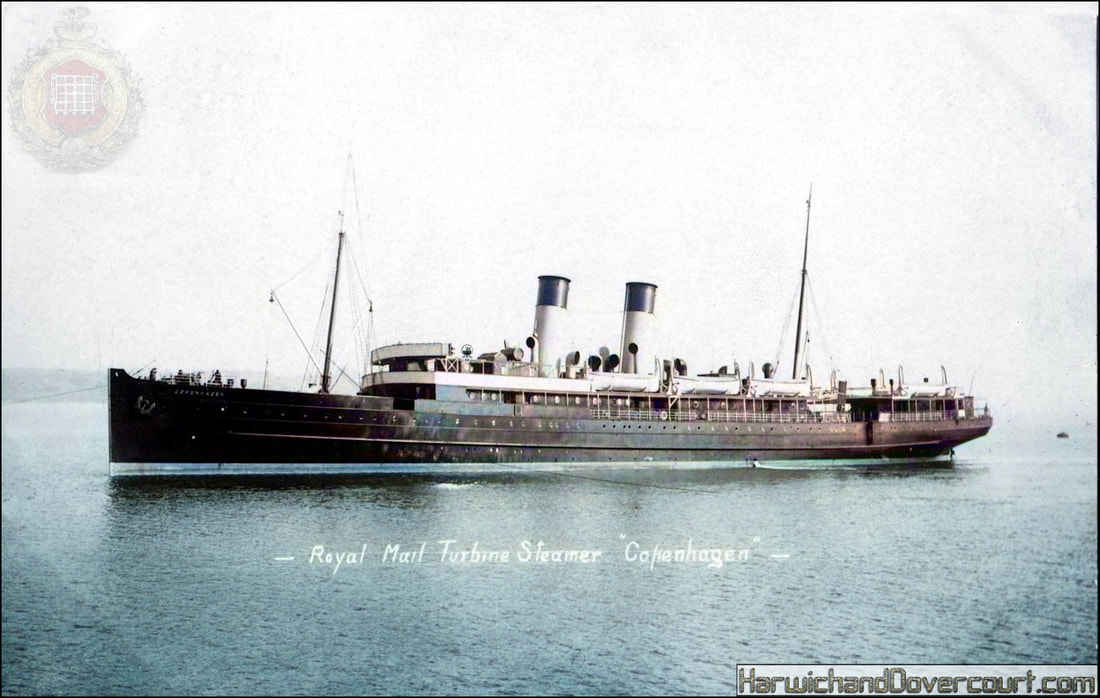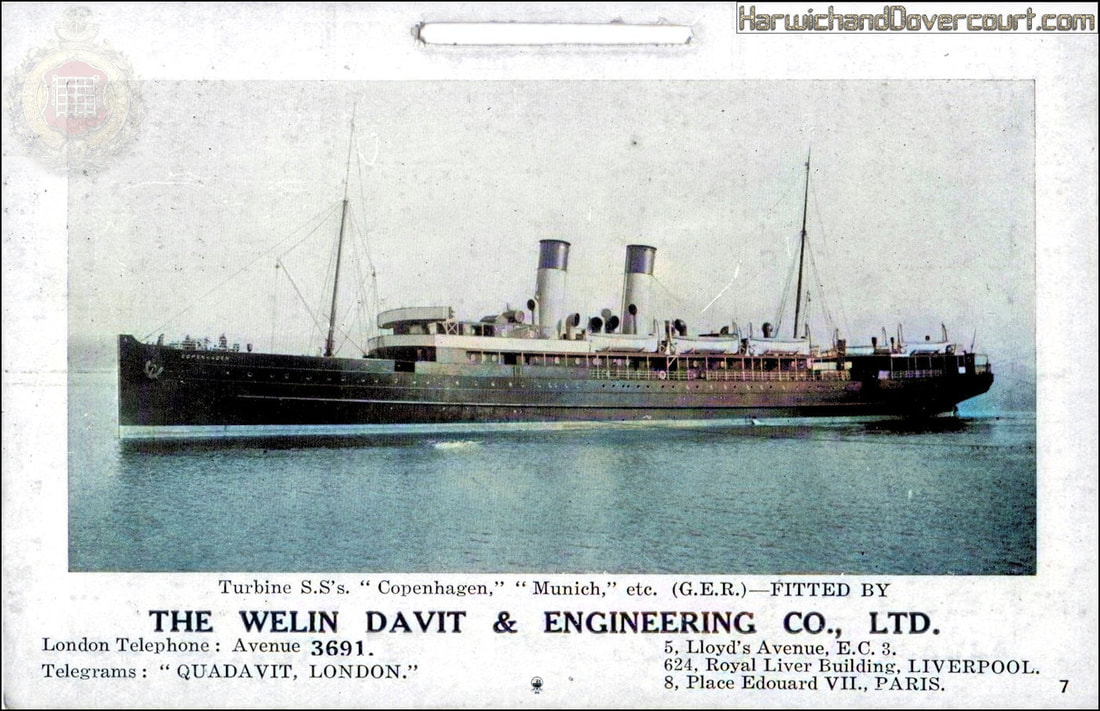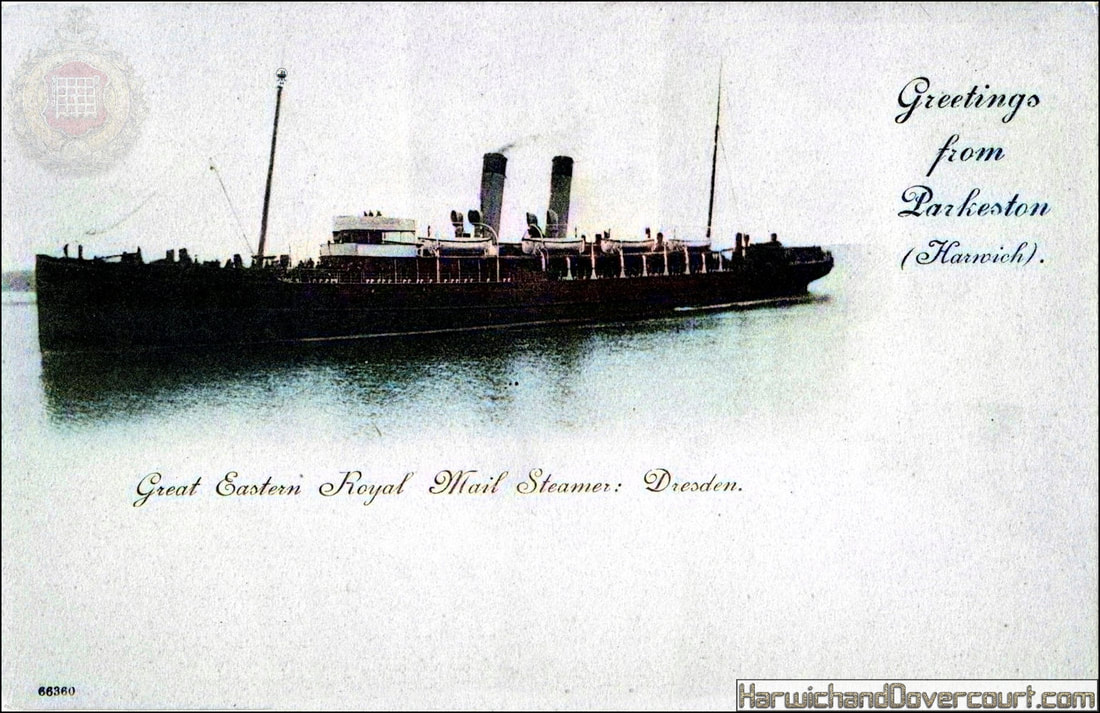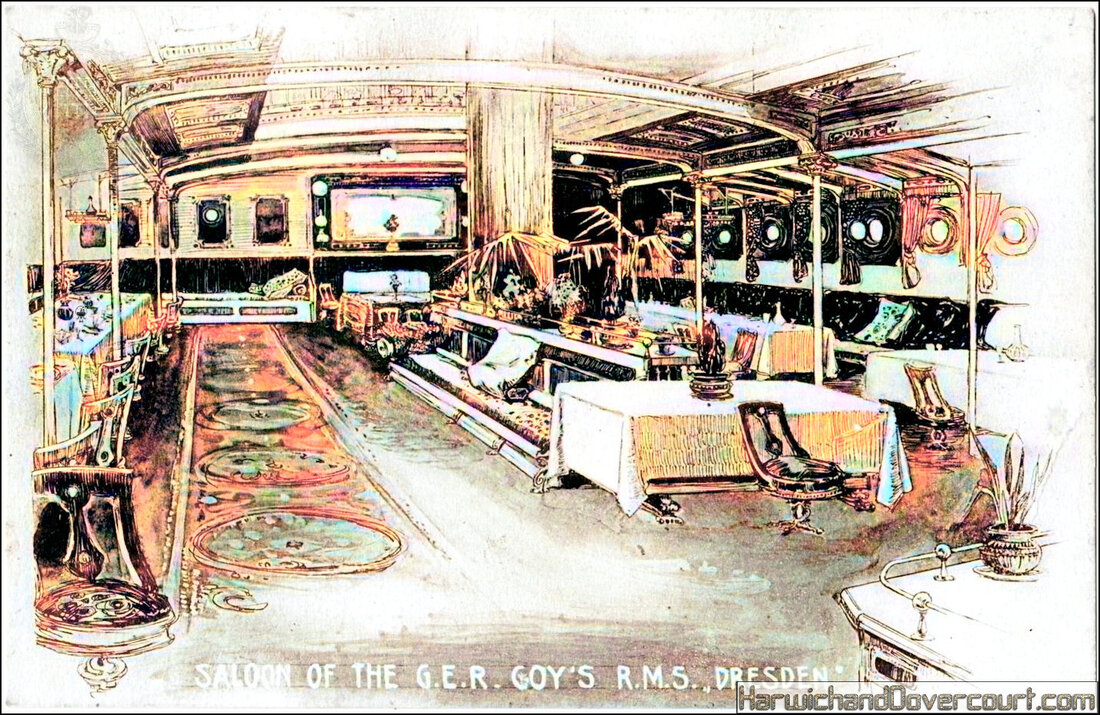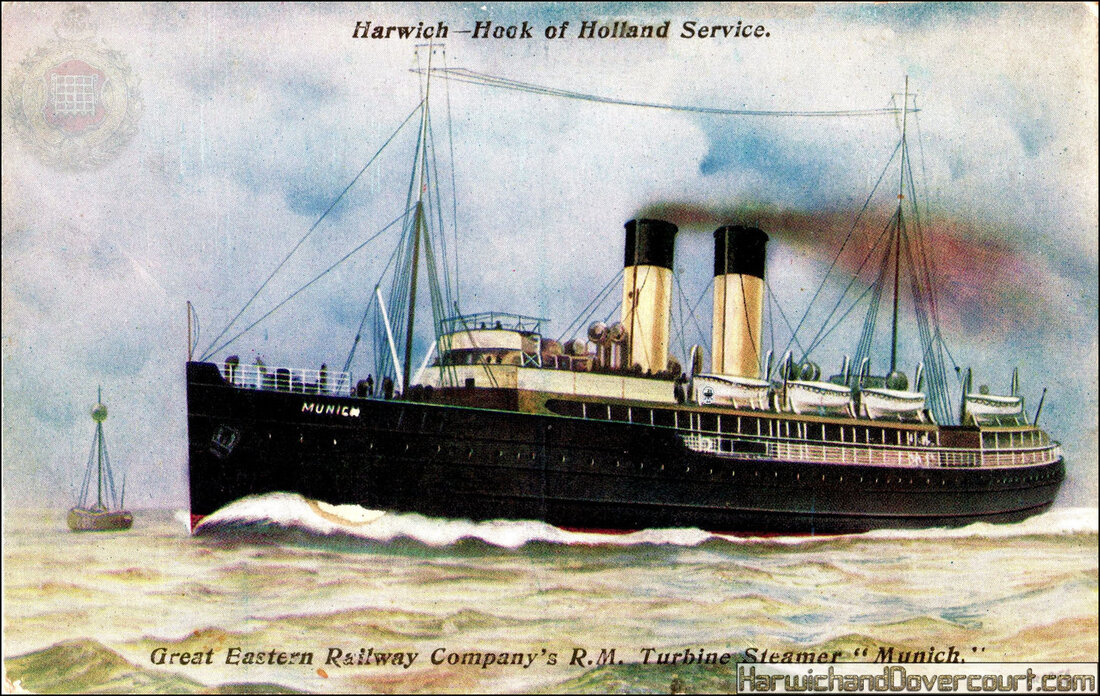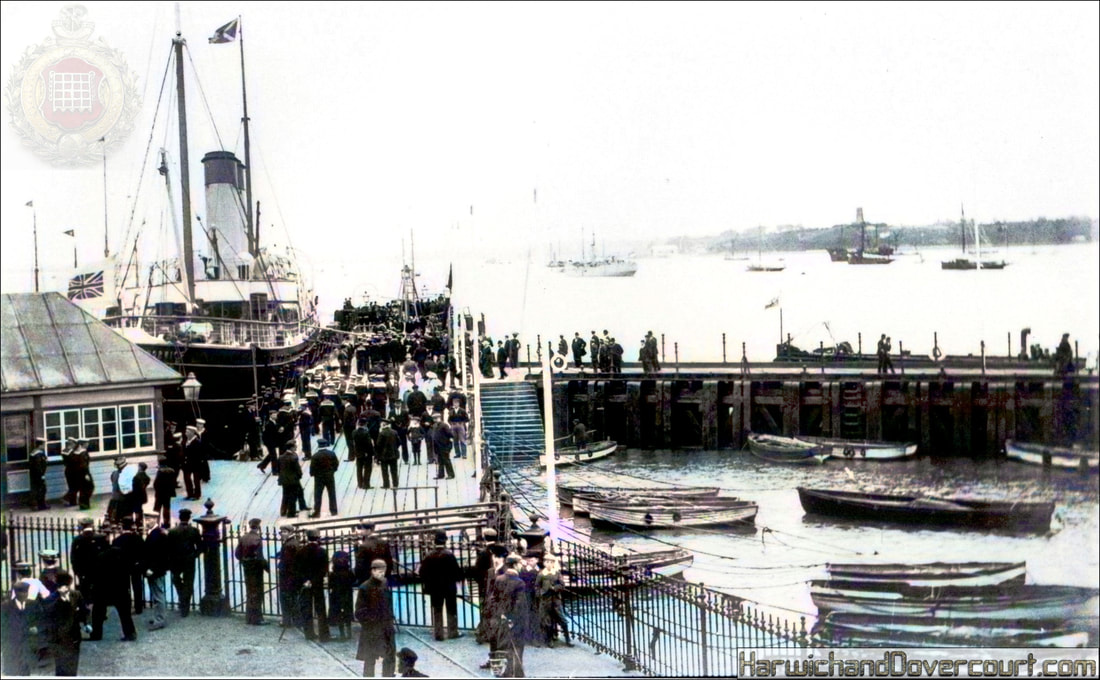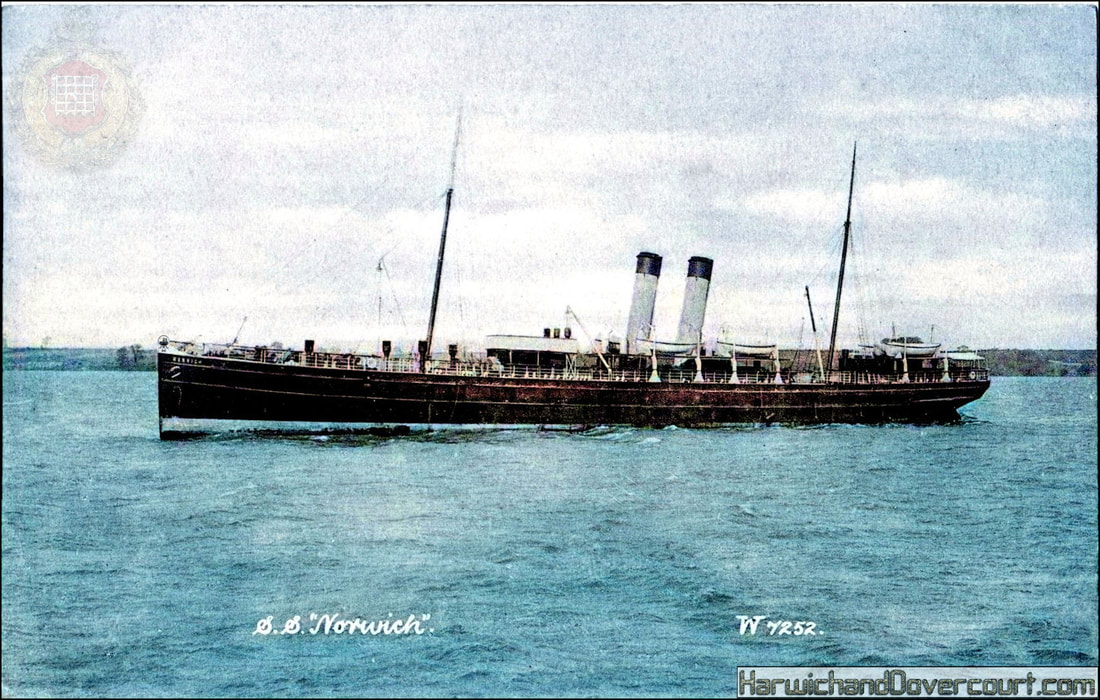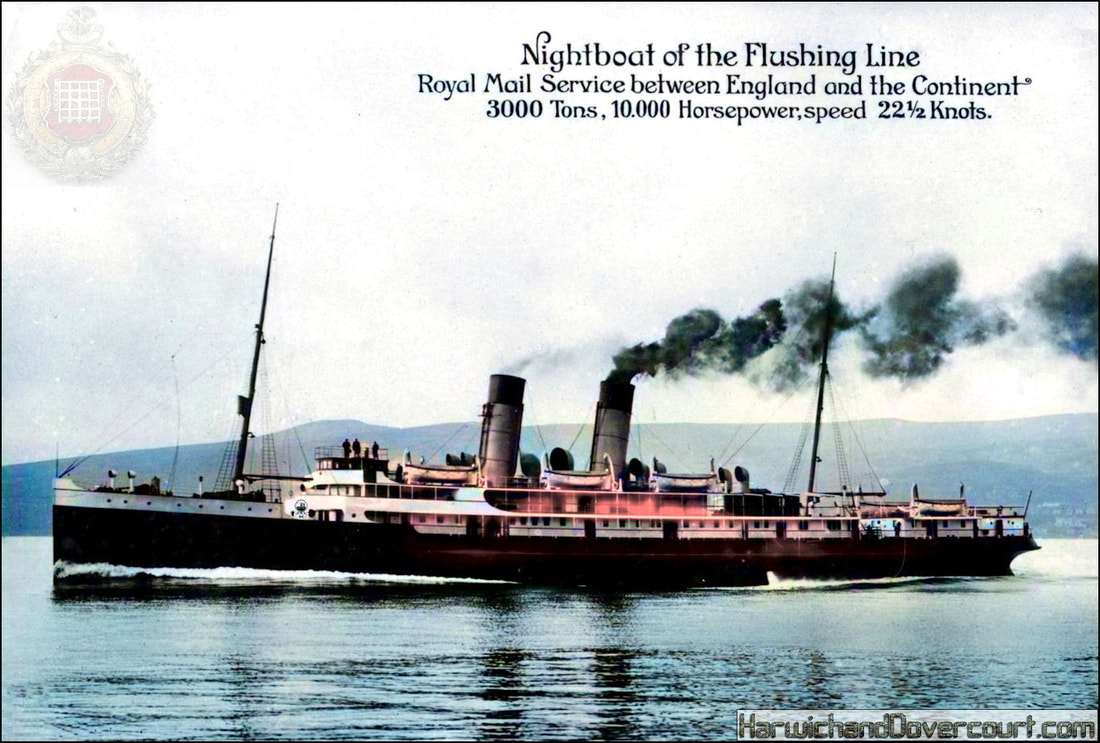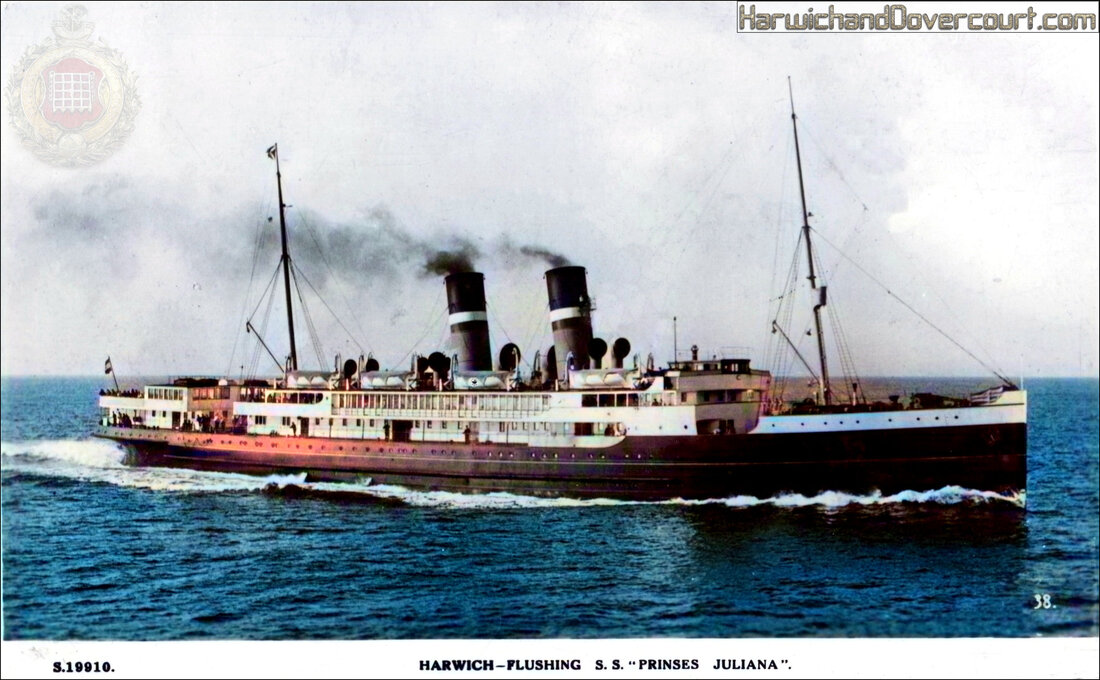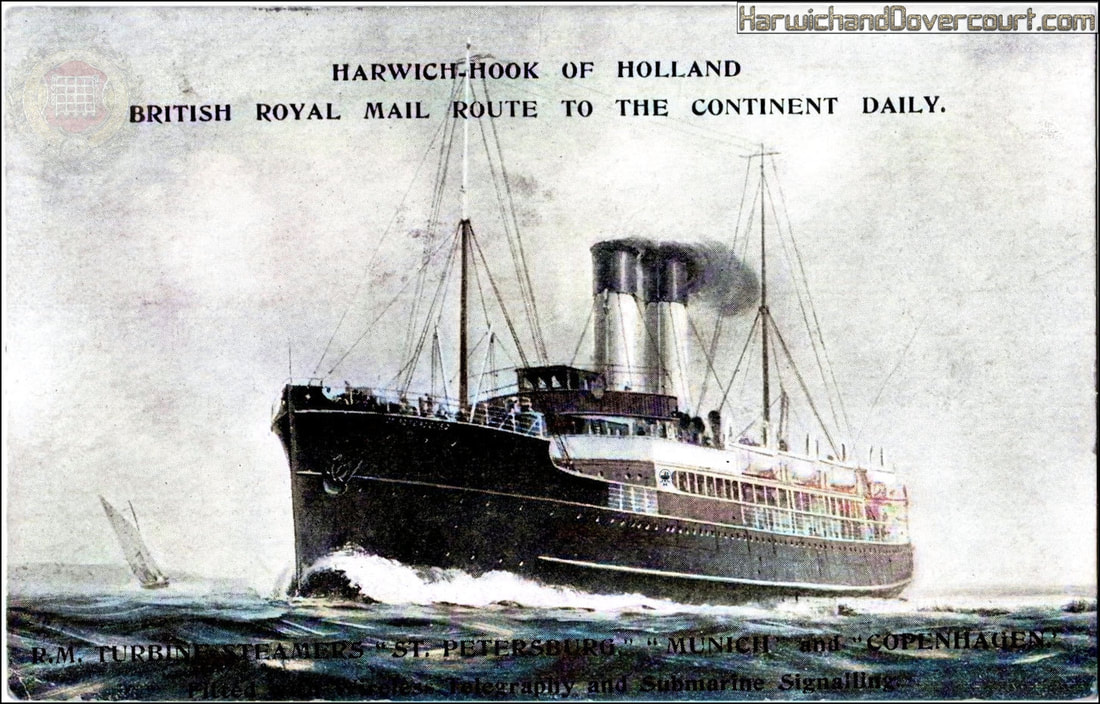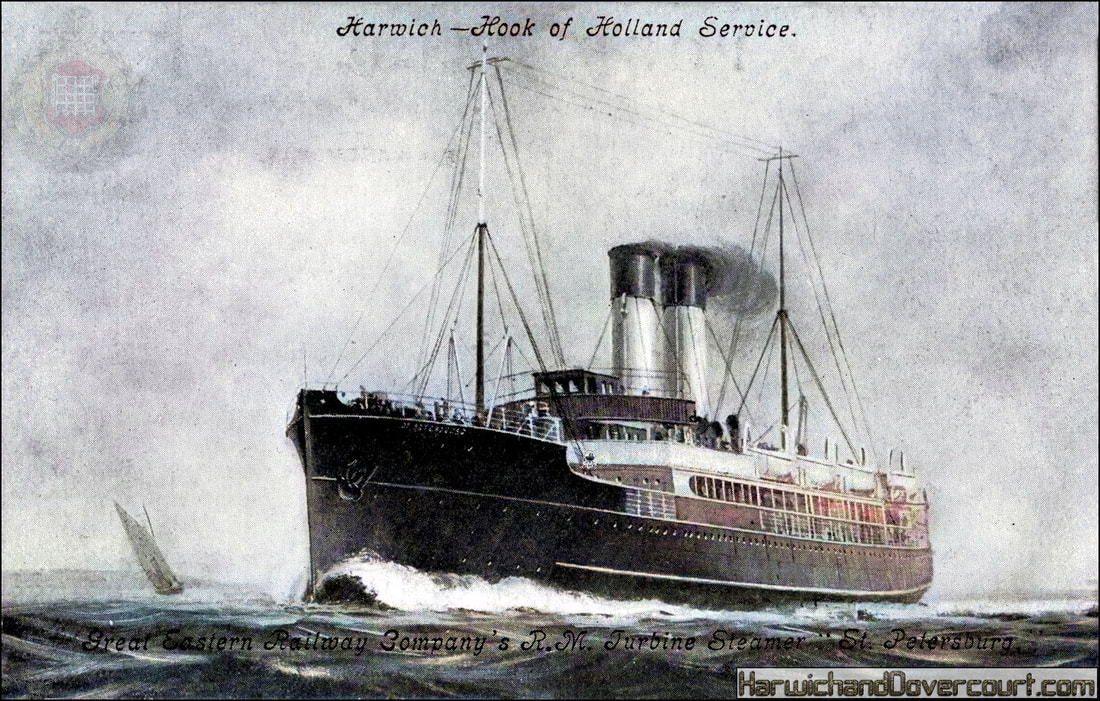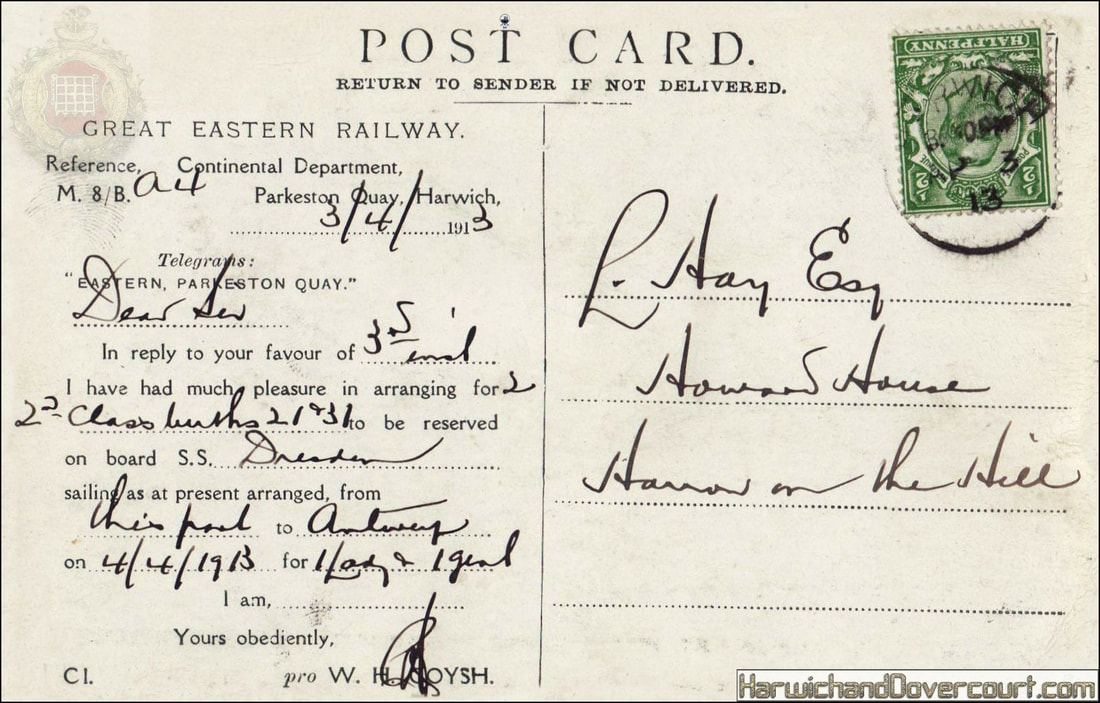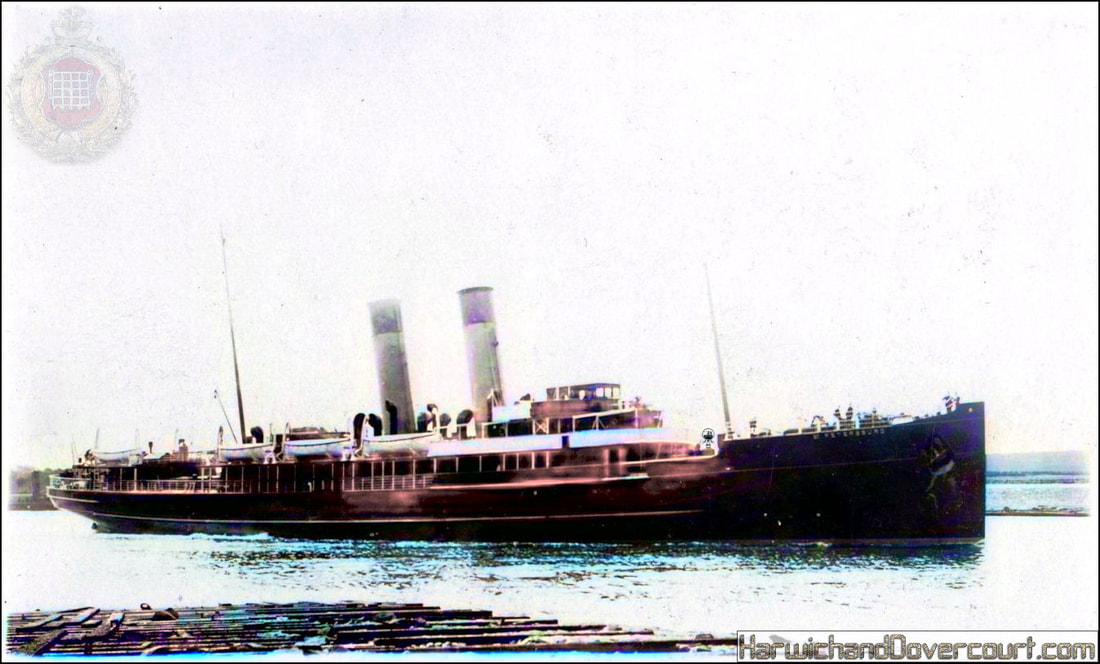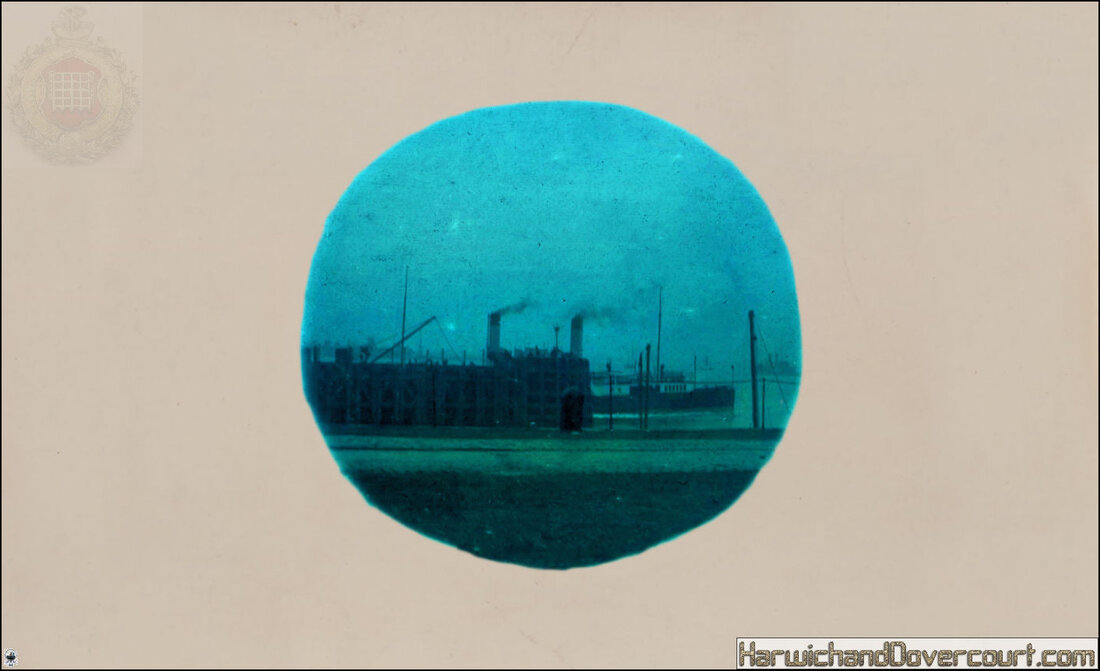A selection of G.E.R. Steamers operating from the Harwich & Parkeston ports.
~ S.S. Amsterdam (1894) ~ On the pier (1908) ~
The S.S. Amsterdam was built in 1894 for the Harwich-Hook route.
The ship was built by Earle's Shipbuilding, Hull for the Great Eastern Railway and launched on 24 January 1894. She was launched by Mrs. Van Hasselt, wife of one of the Directors of the Holland Railway. Many members of Amsterdam Town Council were present at the launch, which showed the importance of this new service to the city. She was the second vessel launched that year by the Great Eastern Railway after the Berlin on 10 January 1894.
Initially placed on the Harwich to Hook of Holland route she was transferred to the Antwerp service in 1910.
In 1923 she fell under the ownership of the London and North Eastern Railway. She was scrapped in 1928.
The ship was built by Earle's Shipbuilding, Hull for the Great Eastern Railway and launched on 24 January 1894. She was launched by Mrs. Van Hasselt, wife of one of the Directors of the Holland Railway. Many members of Amsterdam Town Council were present at the launch, which showed the importance of this new service to the city. She was the second vessel launched that year by the Great Eastern Railway after the Berlin on 10 January 1894.
Initially placed on the Harwich to Hook of Holland route she was transferred to the Antwerp service in 1910.
In 1923 she fell under the ownership of the London and North Eastern Railway. She was scrapped in 1928.
~ G.E.R. Telegram card for a reservation aboard the S.S. Amsterdam (1905) H&D ~
~ S.S. Berlin (1894) ~ Great Eastern Royal Mail Steamer (1904) H&D ~
The S.S. Berlin was a steel ship, which was owned by the Great Eastern Railway and built for use on their ferry service from Harwich and the Hook of Holland, which the company had initiated in 1893.
The Great Eastern Railway ordered three steamships to operate the service. The ships were named Amsterdam, Berlin, and Vienna to publicise some of the rail connections from the Hook of Holland. Berlin was built in 1894 by Earles Shipbuilding and Engineering Company of Hull. She had berths for 218 first- and 120 second-class passengers.
The S Berlin was tragically lost in a storm in 1907, read more here...
The Great Eastern Railway ordered three steamships to operate the service. The ships were named Amsterdam, Berlin, and Vienna to publicise some of the rail connections from the Hook of Holland. Berlin was built in 1894 by Earles Shipbuilding and Engineering Company of Hull. She had berths for 218 first- and 120 second-class passengers.
The S Berlin was tragically lost in a storm in 1907, read more here...
~ SS Bruges (1920) ~ S.14797. G.E.R. Turbine Steamer Bruges (1920) Kingsway H&D ~
The S.S. Bruges was a passenger vessel built for the Great Eastern Railway in 1920.
History
The ship was built by John Brown of Clydebank for the Great Eastern Railway as one of a contract for two new steamers and launched on 20 March 1920. She was launched by Lady Thornton. She was then placed on the Harwich to Antwerp route. In 1923 she was acquired by the London and North Eastern Railway.
She was requisitioned during the World War II as a troopship. She took part in Operation Cycle (the evacuation of Allied troops from Le Havre) and bombed and damaged on 11 June 1940 at Le Havre by Luftwaffe aircraft. She was beached to prevent her from sinking.
History
The ship was built by John Brown of Clydebank for the Great Eastern Railway as one of a contract for two new steamers and launched on 20 March 1920. She was launched by Lady Thornton. She was then placed on the Harwich to Antwerp route. In 1923 she was acquired by the London and North Eastern Railway.
She was requisitioned during the World War II as a troopship. She took part in Operation Cycle (the evacuation of Allied troops from Le Havre) and bombed and damaged on 11 June 1940 at Le Havre by Luftwaffe aircraft. She was beached to prevent her from sinking.
~ 831 LNER R.M.S. Bruges (1920) Kingsway H&D ~
~ S.19893 LNER R.M.S. Bruges (1937) H&D ~
~ S.16168 LNER R.M.S. Bruges (1930) Kingsway H&D ~
~ #64607 G.E.R Continental Steamer Brussels (1903) H&D ~
The S.S. Brussels was a passenger ferry built in 1902 for the British Great Eastern Railway. In 1915, she tried to ram U-33. The ship was captured by Germany in 1916 and her captain, Charles Fryatt was murdered after the Germans discovered his attempted ramming. Brussels was renamed Brugge and used as a depôt ship at Zeebrugge.
In October 1918, Brugge was scuttled by the Germans when they evacuated the port. The ship was raised by the Belgian government and presented to the Admiralty in 1920. She was repaired and later renamed Lady Brussels. She was employed as an Irish Sea ferry, serving until scrapped in 1929.
For more information on the capture and murder of Captain Fryatt click the button below
In October 1918, Brugge was scuttled by the Germans when they evacuated the port. The ship was raised by the Belgian government and presented to the Admiralty in 1920. She was repaired and later renamed Lady Brussels. She was employed as an Irish Sea ferry, serving until scrapped in 1929.
For more information on the capture and murder of Captain Fryatt click the button below
~ Great Eastern Railway Company's R.M.Turbine Steamer Brussels H&D ~
~ S.S. Brussels by Coaling Chute, at Parkeston Quay, Essex H&D ~
~ S.S. Brussels Masters and Deck Hand at Harwich (1904) H&D ~
~ Lady Brussels (1920) Northern H&D ~
~ Voir De Anvers to Harwich ~ SS Brussels (1905) H&D ~
~ Ouai D'Herbouville Antwerp-Sud-Quai (Embarcadere) 1905 ~
~ Ouai d'Herbouville Hangar 9, Embarking at Antwerp South Quay (1905) H&D ~
~ #72801 Great Eastern Continental Steamer - Cambridge (1904) H&D ~
The S.S. Cambridge was a passenger vessel built for the Great Eastern Railway in 1886.
History
The ship was built by Earle's Shipbuilding in Hull for the Great Eastern Railway and launched on 11 October 1886. She was launched by the Mayor of Cambridge (Mr. W. B. Redfern), accompanied by the Deputy-Mayor (Mr. Alderman Deck).
She was placed on the Harwich to Hook of Holland route.
She was sold in 1912 to the Anglo-Ottoman Steamship Company. In 1919 she was acquired by the Administration de Navire a Vapeur Ottomane, Galatea, Constantinople and renamed Gul Nehad. She was sold again in 1922 and renamed Gulnihad.
She was scrapped in 1937.
History
The ship was built by Earle's Shipbuilding in Hull for the Great Eastern Railway and launched on 11 October 1886. She was launched by the Mayor of Cambridge (Mr. W. B. Redfern), accompanied by the Deputy-Mayor (Mr. Alderman Deck).
She was placed on the Harwich to Hook of Holland route.
She was sold in 1912 to the Anglo-Ottoman Steamship Company. In 1919 she was acquired by the Administration de Navire a Vapeur Ottomane, Galatea, Constantinople and renamed Gul Nehad. She was sold again in 1922 and renamed Gulnihad.
She was scrapped in 1937.
~W 7247 S.S. Cambridge (1904) H&D ~
~ S.S. Cambridge in dry-dock at Antwerp (1904) H&D ~
~ #83172 Great Eastern Continental Steamer - Colchester (1904) H&D ~
The S.S. Colchester was a passenger vessel built for the Great Eastern Railway in 1888.
History
The ship was built by Earle's Shipbuilding in Hull for the Great Eastern Railway and launched on 16 October 1888. She was launched by the Mayoress of Colchester (Miss Paxman). She was placed on the Harwich to Hook of Holland route.
Was operating to neutral Holland when captured by Germany on 21 September 1916. Captain Bennett and his crew of 29 were interned at Ruhleben. The Colchester was damaged in an attack on Zeebrugge on 17 February 1917.
She grounded at Kiel in 1918 and was scrapped in 1919.
History
The ship was built by Earle's Shipbuilding in Hull for the Great Eastern Railway and launched on 16 October 1888. She was launched by the Mayoress of Colchester (Miss Paxman). She was placed on the Harwich to Hook of Holland route.
Was operating to neutral Holland when captured by Germany on 21 September 1916. Captain Bennett and his crew of 29 were interned at Ruhleben. The Colchester was damaged in an attack on Zeebrugge on 17 February 1917.
She grounded at Kiel in 1918 and was scrapped in 1919.
~ S.S. Colchester at Parkeston Quay, Essex (1906) by Valentines H&D ~
~ A Great Eastern Railway Telegram Postcard for the S.S. Colchester (1903) H&D ~
~ Great Eastern Railway Company's R.M. Turbine Steamer S.S. Copenhagen (1913) H&D ~
The S.S. Copenhagen was a North Sea passenger ferry that was built in Scotland in 1907. She was the Great Eastern Railway (GER)'s first turbine steamship.
In 1916 she was requisitioned as an ambulance ship. A U-boat sank her in 1917 with the loss of six lives.
Building
Between 1907 and 1910 John Brown & Company of Clydebank, Dumbartonshire built three ferries for the GER. Ida Hamilton, daughter of Claud Hamilton, Chairman of the GER, launched yard number 380 on 22 October 1907 as Copenhagen. The ship was completed that December and registered in 1908. Yard number 384 was launched on 26 August 1908 as Munich. Yard number 397 was launched on 25 April 1910 as the St Petersburg.
Each ship had three steam turbines and three screws. Each turbine drove its respective screw by direct drive. Copenhagen was the GER's first turbine ship. The total power of her three turbines was rated at 1,200 shp, and gave her a speed of 22 knots (41 km/h). Her navigation equipment included submarine signalling.
Copenhagen's registered length was 331.2 ft (100.9 m), her beam was 43.2 ft (13.2 m) and her depth was 17.8 ft (5.4 m). Her tonnages were 2,570 GRT and 1,092 NRT. She had berths for 320 passengers amidships in first class, and 130 in second class aft. Her first class accommodation included 100 double cabins, a 62-seat dining saloon, a ladies' room, and a smoking room.
Passenger ferry
The GER registered Copenhagen at Harwich. Her United Kingdom official number was 123935 and her code letters were HMFQ. Her regular route was between Harwich and Hook of Holland.
By 1910 Copenhagen was equipped with wireless telegraphy. By 1913 her call sign was PQC. By 1914 this had been changed to GPI.
First World War
After the UK entered the First World War, Copenhagen at first remained on her peacetime route, and carried Belgian refugees to Britain. She was then requisitioned, at forst as a troop ship. On 1 January 1916 she was reallocated as an ambulance ship.
On 5 March 1917 she was steaming from Harwich to Hook of Holland when SM UC-61 torpedoed her 8 nautical miles (15 km) east of the Noord Hinder Lightship. Copenhagen sank with the loss of six lives.
In 1916 she was requisitioned as an ambulance ship. A U-boat sank her in 1917 with the loss of six lives.
Building
Between 1907 and 1910 John Brown & Company of Clydebank, Dumbartonshire built three ferries for the GER. Ida Hamilton, daughter of Claud Hamilton, Chairman of the GER, launched yard number 380 on 22 October 1907 as Copenhagen. The ship was completed that December and registered in 1908. Yard number 384 was launched on 26 August 1908 as Munich. Yard number 397 was launched on 25 April 1910 as the St Petersburg.
Each ship had three steam turbines and three screws. Each turbine drove its respective screw by direct drive. Copenhagen was the GER's first turbine ship. The total power of her three turbines was rated at 1,200 shp, and gave her a speed of 22 knots (41 km/h). Her navigation equipment included submarine signalling.
Copenhagen's registered length was 331.2 ft (100.9 m), her beam was 43.2 ft (13.2 m) and her depth was 17.8 ft (5.4 m). Her tonnages were 2,570 GRT and 1,092 NRT. She had berths for 320 passengers amidships in first class, and 130 in second class aft. Her first class accommodation included 100 double cabins, a 62-seat dining saloon, a ladies' room, and a smoking room.
Passenger ferry
The GER registered Copenhagen at Harwich. Her United Kingdom official number was 123935 and her code letters were HMFQ. Her regular route was between Harwich and Hook of Holland.
By 1910 Copenhagen was equipped with wireless telegraphy. By 1913 her call sign was PQC. By 1914 this had been changed to GPI.
First World War
After the UK entered the First World War, Copenhagen at first remained on her peacetime route, and carried Belgian refugees to Britain. She was then requisitioned, at forst as a troop ship. On 1 January 1916 she was reallocated as an ambulance ship.
On 5 March 1917 she was steaming from Harwich to Hook of Holland when SM UC-61 torpedoed her 8 nautical miles (15 km) east of the Noord Hinder Lightship. Copenhagen sank with the loss of six lives.
Royal Mail Steamer Copenhagen (1914) H&D FW
SS Copenhagen Great Eastern Railway (1914) H&D FW
~ #66360 The Great Eastern Railway Steamer SS Dresden (1902) H&D ~
The SS Dresden was a British passenger ship which operated, as such, from 1897 to 1915. She is known as the place of the 1913 disappearance of German engineer Rudolf Diesel, inventor of the diesel engine. The ship was built in 1897 by the Earle Company at Hull for the Great Eastern Railway. She operated on the North Sea route between Harwich and the Hook of Holland. She was later renamed the HMS Louvain in 1915 and was used by the Royal Navy in World War I, until her loss in 1918.
Diesel's Disappearance
Dresden in Antwerp Harbour, 1913
On 29 September 1913 Rudolf Diesel, the German engineer who invented the diesel engine, boarded Dresden at Antwerp, Belgium on his way to a meeting in London. He retired to his cabin about 22:00 Hrs with a request to be called at 06:15 Hrs in the morning, but he was not seen alive again. Later a Dutch ship found a body floating in the sea and from the items and clothes recovered the remains were identified as Diesel's.
Royal Navy
In 1915 Dresden was taken over by the British Admiralty as an armed boarding steamer and renamed HMS Louvain. On 21 January 1918, she was torpedoed by the Imperial German Navy submarine SM UC-22 in the Aegean Sea, with the loss of seven officers and 217 men. There were only 16 survivors.
The dead included 70 Maltese naval ratings, which made the loss of the ship Malta's largest incident of loss of life during the war. A Naval and Dockyard Families Help Society was set up to help the families of the Maltese victims of the sinking.
Diesel's Disappearance
Dresden in Antwerp Harbour, 1913
On 29 September 1913 Rudolf Diesel, the German engineer who invented the diesel engine, boarded Dresden at Antwerp, Belgium on his way to a meeting in London. He retired to his cabin about 22:00 Hrs with a request to be called at 06:15 Hrs in the morning, but he was not seen alive again. Later a Dutch ship found a body floating in the sea and from the items and clothes recovered the remains were identified as Diesel's.
Royal Navy
In 1915 Dresden was taken over by the British Admiralty as an armed boarding steamer and renamed HMS Louvain. On 21 January 1918, she was torpedoed by the Imperial German Navy submarine SM UC-22 in the Aegean Sea, with the loss of seven officers and 217 men. There were only 16 survivors.
The dead included 70 Maltese naval ratings, which made the loss of the ship Malta's largest incident of loss of life during the war. A Naval and Dockyard Families Help Society was set up to help the families of the Maltese victims of the sinking.
~ Saloon of the G.E.R. Goy's R.M.S. Dresden (1908) H&D ~
~ Great Eastern Railway Company's S.S. Dresden (1913) H&D ~
~ Great Eastern Railway Company's R.M.Turbine Steamer Munich (1913) H&D ~
The Royal Mail Turbine Steamer Munich was a North Sea passenger ferry that was built in Scotland in 1908 for the Great Eastern Railway (GER). In the 1923 railway grouping she passed to the new London and North Eastern Railway (LNER). She was scrapped in England in 1950.
In 1914 she was requisitioned as a hospital ship and renamed St. Denis. Early in the Second World War St Denis was requisitioned as a troop ship. In 1940 the Kriegsmarine captured her and renamed her Skorpion, and then Barbara. She returned to Allied control in 1945.
Building
Munich was the second of three sister ships that John Brown & Company of Clydebank, Dumbartonshire built for the GER. She was preceded by Copenhagen, launched in 1907, and followed by St Petersburg, launched in 1910. Brown built Munich as yard number 384. A Miss Lawson launched her on 26 August 1908. She was the daughter of Sir Arthur Tredgold Lawson, Baronet, who was a GER director.
Munich's registered length was 331 ft (100.9 m), her beam was 43.2 ft (13.2 m) and her depth was 17.8 ft (5.4 m). Her tonnages were 2,410 GRT and 1,029 NRT. She had three steam turbines and three screws. Each turbine drove its respective screw by direct drive. The combined power of her three turbines was rated at 1,325 NHP.
Career
The GER registered Munich at Harwich. Her United Kingdom official number was 123938 and her code letters were HNJM. Her regular route was between Harwich and Antwerp.
By 1910 Munich was equipped with submarine signalling and wireless telegraphy. By 1913 her call sign was PQM. By 1914 this had been changed to GPJ.
In 1914 the Admiralty requisitioned Munich, had her converted into a hospital ship, and renamed her St. Denis. After the First World War she was returned to the GER, which in 1923 was absorbed by the new LNER. In 1932 the LNER relegated her to secondary services.
By 1930 St. Denis' call sign was GRNT. By 1934 this had superseded her code letters.
Early in the Second World War St Denis was requisitioned as a troop ship. The German invasion of the Netherlands in May 1940 caught her in Amsterdam, so she was scuttled. The Kriegsmarine had her raised, renamed her Skorpion, and started to have her converted into a mine-layer. The conversion was discontinued, and she was renamed Barbara and used as an accommodation ship.
In 1945 the Allies found Barbara at Kiel, providing accommodation for Kiel University. In 1950 she was towed to Sunderland, where she arrived on 2 March to be scrapped by Thomas Young and Sons.
In 1914 she was requisitioned as a hospital ship and renamed St. Denis. Early in the Second World War St Denis was requisitioned as a troop ship. In 1940 the Kriegsmarine captured her and renamed her Skorpion, and then Barbara. She returned to Allied control in 1945.
Building
Munich was the second of three sister ships that John Brown & Company of Clydebank, Dumbartonshire built for the GER. She was preceded by Copenhagen, launched in 1907, and followed by St Petersburg, launched in 1910. Brown built Munich as yard number 384. A Miss Lawson launched her on 26 August 1908. She was the daughter of Sir Arthur Tredgold Lawson, Baronet, who was a GER director.
Munich's registered length was 331 ft (100.9 m), her beam was 43.2 ft (13.2 m) and her depth was 17.8 ft (5.4 m). Her tonnages were 2,410 GRT and 1,029 NRT. She had three steam turbines and three screws. Each turbine drove its respective screw by direct drive. The combined power of her three turbines was rated at 1,325 NHP.
Career
The GER registered Munich at Harwich. Her United Kingdom official number was 123938 and her code letters were HNJM. Her regular route was between Harwich and Antwerp.
By 1910 Munich was equipped with submarine signalling and wireless telegraphy. By 1913 her call sign was PQM. By 1914 this had been changed to GPJ.
In 1914 the Admiralty requisitioned Munich, had her converted into a hospital ship, and renamed her St. Denis. After the First World War she was returned to the GER, which in 1923 was absorbed by the new LNER. In 1932 the LNER relegated her to secondary services.
By 1930 St. Denis' call sign was GRNT. By 1934 this had superseded her code letters.
Early in the Second World War St Denis was requisitioned as a troop ship. The German invasion of the Netherlands in May 1940 caught her in Amsterdam, so she was scuttled. The Kriegsmarine had her raised, renamed her Skorpion, and started to have her converted into a mine-layer. The conversion was discontinued, and she was renamed Barbara and used as an accommodation ship.
In 1945 the Allies found Barbara at Kiel, providing accommodation for Kiel University. In 1950 she was towed to Sunderland, where she arrived on 2 March to be scrapped by Thomas Young and Sons.
~ #31381 G.E.R. Steamer Norwich, Valentine Series (1904) H&D ~

The S.S. Norwich was a passenger vessel built for the Great Eastern Railway in 1883
History
The ship was built by Earle's Shipbuilding of Hull for the Great Eastern Railway and launched on 6 March 1883. She was one of a pair of new steamers ordered by the Great Eastern Railway, the other being Ipswich. She was launched by the Mayoress of Norwich.
She was placed on the Harwich to Rotterdam and Antwerp route.
She was withdrawn from service in 1905 and sold in 1906 to the Channel Drydock and Shipbuilding Company. After a succession of subsequent ownership in Cape Verde, Montevideo, New York and Mexico, she sank in 1921 when under the ownership of the Mexican Fruit and Steamship Company.
History
The ship was built by Earle's Shipbuilding of Hull for the Great Eastern Railway and launched on 6 March 1883. She was one of a pair of new steamers ordered by the Great Eastern Railway, the other being Ipswich. She was launched by the Mayoress of Norwich.
She was placed on the Harwich to Rotterdam and Antwerp route.
She was withdrawn from service in 1905 and sold in 1906 to the Channel Drydock and Shipbuilding Company. After a succession of subsequent ownership in Cape Verde, Montevideo, New York and Mexico, she sank in 1921 when under the ownership of the Mexican Fruit and Steamship Company.
~ The Steamer Norwich on Harwich Pier (1905) H&D ~
~ W 7252 S.S.Norwich (1905) Wyndham H&D ~
~ Prinses Juliana in 1909 Flushing Night Boat H&D ~
The Great Eastern Railway received their first turbines in 1903, and accelerated their services.
S.M.Z. (Stoomvaart Maatschappij Zeeland was a Dutch ferry operator that ran services from the Netherlands to the United Kingdom between 1875 and 1989.) Responded by building three turbines of their own at Fairfields, The Prinses Juliana (seen above), Oranje Nassau and Mecklenberg. The turbines were used on the night service, with the less competitive day service being operated by the displaced 1895 paddle steamers. After one year, the turbines were moved to Folkestone in 1911, since the Medway was unsuitable for their greater draft than the paddlers. The distance from Vlissingen (Flushing) to Folkestone was 92 miles, compared to 112 miles from Queenborough. The day service remained at Queenborough. Prinses Juliana and Mecklenberg were lost to German mines within days of each other early in 1916, and replacements were built in 1920 and 1922, becoming the Prinses Juliana and Mecklenberg. These were built in Holland using the original Fairfield drawings. Oranje Nassau also survived the Second War, and re-opened services from Harwich to Holland in 1946 with the Prague of the LNER. The following year she moved to the day service. When the 1939 diesels returned to service in 1948, Mecklenberg was chartered to Batavier Line for their Rotterdam-Tilbury service. This continued until 1952, when she returned to the Harwich-Hook route. She was scrapped in 1954.
S.M.Z. (Stoomvaart Maatschappij Zeeland was a Dutch ferry operator that ran services from the Netherlands to the United Kingdom between 1875 and 1989.) Responded by building three turbines of their own at Fairfields, The Prinses Juliana (seen above), Oranje Nassau and Mecklenberg. The turbines were used on the night service, with the less competitive day service being operated by the displaced 1895 paddle steamers. After one year, the turbines were moved to Folkestone in 1911, since the Medway was unsuitable for their greater draft than the paddlers. The distance from Vlissingen (Flushing) to Folkestone was 92 miles, compared to 112 miles from Queenborough. The day service remained at Queenborough. Prinses Juliana and Mecklenberg were lost to German mines within days of each other early in 1916, and replacements were built in 1920 and 1922, becoming the Prinses Juliana and Mecklenberg. These were built in Holland using the original Fairfield drawings. Oranje Nassau also survived the Second War, and re-opened services from Harwich to Holland in 1946 with the Prague of the LNER. The following year she moved to the day service. When the 1939 diesels returned to service in 1948, Mecklenberg was chartered to Batavier Line for their Rotterdam-Tilbury service. This continued until 1952, when she returned to the Harwich-Hook route. She was scrapped in 1954.
~ Princess Juliana Leaving Harwich, (1934) H&D ~
~ S.19910. Harwich-Flushing S.S. Prinses Juliana (1938) Kingsway H&D ~
~ Great Eastern Railway Company's R.M.Turbine Steamer St Petersburg (1913) H&D ~
The S.S. St Petersburg was a North Sea passenger ferry that was built in Scotland in 1908 for the Great Eastern Railway (GER). In the 1923 railway grouping she passed to the new London and North Eastern Railway (LNER). She was sunk by enemy action in 1941.
The Admiralty requisitioned her in both world wars as a troop ship. In 1915 she was renamed Archangel.
Building
St Petersburg was the third of three sister ships that John Brown & Company of Clydebank, Dumbartonshire built for the GER. She was preceded by Copenhagen, launched in 1907 and Munich, launched in 1908. Brown built St Petersburg as yard number 397. A Miss Green launched her on 25 April 1910. She was the daughter of Frederick Green, a GER director.
St Petersburg's registered length was 330.8 ft (100.8 m), her beam was 43.2 ft (13.2 m) and her depth was 18.8 ft (5.7 m). Her tonnages were 2,448 GRT and 1,039 NRT. She had three steam turbines and three screws. Each turbine drove its respective screw by direct drive. She was equipped with submarine signalling and wireless telegraphy.
Career
The GER registered St Petersburg at Harwich. Her United Kingdom official number was 123940 and her code letters were HRFS Her regular route was between Harwich and Hook of Holland.
By 1913 St Petersburg's wireless telegraph call sign was PQP. By 1914 it had been changed to GPK.
In 1915 the Admiralty requisitioned St Petersburg as a cross-Channel troop ship, and renamed her Archangel. After the First World War she was returned to the GER, which in 1923 was absorbed by the new LNER.
On 20 January 1925 she ran aground at the Hook of Holland. Three tugs brought her passengers ashore.
By 1930 Archangel's call sign was GRNV. By 1934 this had superseded her code letters.
Loss
In the Second World War Archangel was again requisitioned as a troop ship. On 16 May 1941 she embarked 182 and 196 batteries of 65th (The Manchester Regiment) Anti-Aircraft Brigade at Kirkwall to take them to Aberdeen. The destroyer HMS Blankney escorted her.
SS St Petersburg is located in Blackdog, Scotland where Archangel was attacked and beached
Just before midnight that night, three German Heinkel He 111 bomber aircraft attacked the two ships in the North Sea at position 57°55′N 2°03′W. One aircraft, flying at an altitude of 50 feet (15 m), dropped two bombs, one of which hit Archangel in her engine room and boiler room, caused a boiler explosion, and severed communication between the fore and aft of the ship. The same aircraft returned at an altitude of 500 feet (150 m) to strafe Archangel, as the other two He 111s engaged Blankney. Both ships returned fire, and Blankney circled Archangel at speed. The He 111 that attacked Archangel made three runs, and was then damaged and crashed into the sea. The other two aircraft then withdrew.
Blankney launched her boats to rescue survivors, and went alongside Archangel to complete the evacuation. Blankney's surgeon came aboard to assist Archangel's medical officer. Blankney reached Aberdeen about 0800 hrs on 17 May. Casualties included 38 killed and 18 wounded in 182 battery; and three killed and 24 wounded in 196 battery; all suffering from burns. Archangel's Master, Captain AP Sutton, was badly wounded. Accounts differ as to the number of casualties in his crew.
Also on 17 May, either Blankney or a tug (accounts differ) took Archangel in tow. The troop ship beached at Blackdog, just north of Aberdeen, and broke into four pieces.
The Admiralty requisitioned her in both world wars as a troop ship. In 1915 she was renamed Archangel.
Building
St Petersburg was the third of three sister ships that John Brown & Company of Clydebank, Dumbartonshire built for the GER. She was preceded by Copenhagen, launched in 1907 and Munich, launched in 1908. Brown built St Petersburg as yard number 397. A Miss Green launched her on 25 April 1910. She was the daughter of Frederick Green, a GER director.
St Petersburg's registered length was 330.8 ft (100.8 m), her beam was 43.2 ft (13.2 m) and her depth was 18.8 ft (5.7 m). Her tonnages were 2,448 GRT and 1,039 NRT. She had three steam turbines and three screws. Each turbine drove its respective screw by direct drive. She was equipped with submarine signalling and wireless telegraphy.
Career
The GER registered St Petersburg at Harwich. Her United Kingdom official number was 123940 and her code letters were HRFS Her regular route was between Harwich and Hook of Holland.
By 1913 St Petersburg's wireless telegraph call sign was PQP. By 1914 it had been changed to GPK.
In 1915 the Admiralty requisitioned St Petersburg as a cross-Channel troop ship, and renamed her Archangel. After the First World War she was returned to the GER, which in 1923 was absorbed by the new LNER.
On 20 January 1925 she ran aground at the Hook of Holland. Three tugs brought her passengers ashore.
By 1930 Archangel's call sign was GRNV. By 1934 this had superseded her code letters.
Loss
In the Second World War Archangel was again requisitioned as a troop ship. On 16 May 1941 she embarked 182 and 196 batteries of 65th (The Manchester Regiment) Anti-Aircraft Brigade at Kirkwall to take them to Aberdeen. The destroyer HMS Blankney escorted her.
SS St Petersburg is located in Blackdog, Scotland where Archangel was attacked and beached
Just before midnight that night, three German Heinkel He 111 bomber aircraft attacked the two ships in the North Sea at position 57°55′N 2°03′W. One aircraft, flying at an altitude of 50 feet (15 m), dropped two bombs, one of which hit Archangel in her engine room and boiler room, caused a boiler explosion, and severed communication between the fore and aft of the ship. The same aircraft returned at an altitude of 500 feet (150 m) to strafe Archangel, as the other two He 111s engaged Blankney. Both ships returned fire, and Blankney circled Archangel at speed. The He 111 that attacked Archangel made three runs, and was then damaged and crashed into the sea. The other two aircraft then withdrew.
Blankney launched her boats to rescue survivors, and went alongside Archangel to complete the evacuation. Blankney's surgeon came aboard to assist Archangel's medical officer. Blankney reached Aberdeen about 0800 hrs on 17 May. Casualties included 38 killed and 18 wounded in 182 battery; and three killed and 24 wounded in 196 battery; all suffering from burns. Archangel's Master, Captain AP Sutton, was badly wounded. Accounts differ as to the number of casualties in his crew.
Also on 17 May, either Blankney or a tug (accounts differ) took Archangel in tow. The troop ship beached at Blackdog, just north of Aberdeen, and broke into four pieces.
